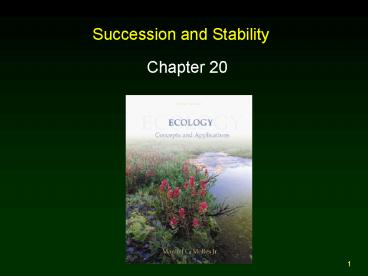Succession and Stability PowerPoint PPT Presentation
1 / 26
Title: Succession and Stability
1
Succession and Stability
- Chapter 20
2
Outline
- Introduction
- Primary Succession
- Secondary Succession
- Disturbance
- Ecosystem Recovery
- Mechanisms of Succession
- Community and Ecosystem Stability
3
Introduction
- Succession Gradual change in plant and animal
communities in an area following disturbance. - Primary succession on newly exposed geological
substrates. - Secondary succession following disturbance that
does not destroy soil. - Climax Community Late successional community
that remains stable until disrupted by
disturbance.
4
Primary Succession at Glacier Bay
- Reiners et.al. studied changes in plant diversity
during succession. - Total number of plant species increased with plot
age. - Species richness increased rapidly in early years
of succession and more slowly during later
stages. - Not all groups increased in density throughout
succession.
5
Primary Succession at Glacier Bay
6
Secondary Succession in Temperate Forests
- Oosting found number of woody plant species
increased during secondary succession at Piedmont
Plateau. - Johnston and Odum found increase in bird
diversity across successional sequence closely
paralleled increase in woody plant diversity
observed by Oosting.
7
Succession in Stream Communities
- Fisher studied rapid succession in Sycamore
Creek, AZ. - Evaporation nearly equals precipitation - flows
generally low and intermittent. - Subject to flash floods.
- Observed rapid changes in diversity and
composition of algae and invertebrates. - Invertebrates found refuge because many adults in
aerial stage. - Re-colonized after flooding.
8
Ecosystem Changes During Succession
- Chapin documented substantial changes in
ecosystem structure during succession at Glacier
Bay. - Total soil depth and depth of all major soil
horizons show significant increase from pioneer
community. - In addition, organic content, moisture, and N
concentrations all increased. - Physical and biological systems are inseparable.
9
Ecosystem Changes During Succession
10
Four Million Years of Ecosystem Change
- Chronosequences such as that found at Glacier Bay
are limited. - Hawaiian Islands have formed over hot spots on
the Pacific tectonic plate, forming an island
chain varying greatly in age. - Hedin et.al. found differing patterns of nutrient
distribution across the chronosequence.
11
Recovery of Nutrient Retention Following
Disturbance
- Bormann and Likens found felling trees in Hubbard
Brook substantially increased nutrient losses. - Herbicide used to suppress regrowth.
- When application stopped, succession proceeded,
nutrient losses decreased,and primary production
increased. - Vegetation cant account for all nutrient loss.
- Reduced nutrient amounts in ecosystem.
12
(No Transcript)
13
Model of Ecosystem Recovery
- Biomass Accumulation Model
- Reorganization (10-20 yrs)
- Forest loses biomass and nutrients.
- Aggradation (100 yrs)
- Ecosystem reaches peak biomass.
- Transition
- Biomass declines from peak.
- Steady-State
- Biomass fluctuates around mean.
14
Mechanisms of Succession
- Clements
- Facilitation
- Connell and Slayter
- Facilitation
- Tolerance
- Inhibition
15
Mechanisms of Succession
16
Facilitation
- Proposes many species may attempt to colonize
newly available space. - Only certain species will establish.
- Colonizers Pioneer Species modify environment
so it becomes less suitable for themselves and
more suitable for species of later successional
stages.
17
Tolerance
- Initial stages of colonization are not limited to
pioneer species. - Early successional species do not facilitate
later successional species.
18
Inhibition
- Early occupants of an area modify the environment
in a way that makes it less suitable for both
early and late successional species. - Early arrivals inhibit colonization by later
arrivals. - Assures late successional species dominate an
area because they live a long time and resist
damage by physical and biological factors.
19
Successional Mechanisms in Rocky Intertidal Zone
- Sousa investigated mechanisms behind succession
of algae and barnacles in intertidal boulder
fields. - If the inhibition model is in effect, early
successional species should be more vulnerable to
mortality. - Results showed early successional species had
lowest survivorship and were more vulnerable to
herbivores.
20
Mechanisms in Primary Succession on a Volcanic
Substrate
- 1980 - Mt St. Helens, Washington erupted.
- Disturbance set stage for succession.
- Avalanche debris, hot volcanic ash and pumice
killed all plant life. - Morris and Wood studied influences of
facilitation, tolerance, and inhibition on early
succession on pumice plains. - Found complex blend of influences.
21
Community and Ecosystem Stability
- Stability Absence of change.
- Resistance Ability to maintain structure and
function in face of potential disturbance. - Resilience Ability to recover from disturbance.
22
Park Grass Experiment
- Hertfordshire, England
- Studied effects of fertilizer treatments.
- Continued for 150 years.
- Silverton investigated ecosystem stability.
- Used community composition variability as measure
of stability. - Represented composition as proportion of
community consisting of each plant form.
23
Park Grass Experiment
- Dodd showed that although community stability is
present, populations of individual species can
change substantially. - Stability depends on resolution an area is
investigated at. - Valett studied interaction between surface and
subsurface waters. - Flash floods devastated biotic community.
- Spatial relationships of zones stable.
- Geomorphology of landscape.
24
Desert Stream Stability
- Valett studied interaction between surface and
subsurface waters. - Flash floods devastated biotic community.
- Spatial relationships of zones stable.
- Geomorphology of landscape.
25
Review
- Introduction
- Primary Succession
- Secondary Succession
- Disturbance
- Ecosystem Recovery
- Mechanisms of Succession
- Community and Ecosystem Stability
26
(No Transcript)

